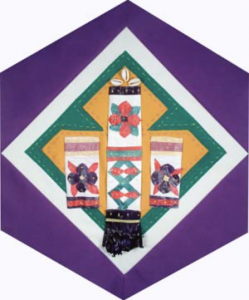Tuvalu

The Block
The tropical climate of Tuvalu and the spirited nature of its people are captured in this block, which was made from a native banana leaf skirt, donated by Manuila Tausi. Three white tabs that decoratively hung from the skirt’s waist band, feature geometric and floral patterns in red, green and yellow. Each is stitched in primitive straight stitches with a yellow raffia type of fibre. At the bottom of the centre tab is a replica of the skirts traditionally worn at celebrations of all kinds.
Cowrie shells, which at one time were used as currency throughout the Pacific Islands, embellish the top of this tab. Today shells are used extensively in handicrafts and as such are given to relatives or friends leaving Tuvalu. They are also given to guests at special events and are worn by men and women when performing the Fatele, a national dance. Layered cottons, decorated with the same stitching as the tabs, reflect the multi-layer design and colour of the skirts.
Tuvalu, at 26 km2, is a small island nation in the southwest Pacific Ocean. It is situated about half-way between Hawaii and Australia. Formerly known as the Ellice Islands, it was once part of the British Gilbert and Ellice Islands Colony. It separated from the Gilberts, which are now Kiribati, and became independent in 1978. The country is the worlds’ fourth smallest in terms of land area and comprises a chain of nine coral islands: five atolls and four single islands. Originally only eight of the islands were inhabited, hence its name which means ‘eight standing together.’ Since none of the islands has an elevation of more than five metres (16 ft.), Tuvalu is one of the most low-lying countries in the world, and is vulnerable to rising sea levels caused by global warming. Residents worry the islands will eventually be washed away, forcing their entire population to be re-located. Almost all the inhabitants of Tuvalu are ethnic Polynesians and the official languages are English and Tuvaluan.
Most Tuvaluans live in villages built around a church and maneapa, the meeting place. The maneapas are built without walls and their distinctive white colour is obtained by burning dead coral and using the white powder to paint the structure of the building. They serve as meeting places for local council of elders, or to celebrate weddings and community activities. The traditional community system and values still survive. Community members each have their own salanga, or task, to perform for the group and skills such as fishing and house building are passed down from father to son. Subsistence farming and fishing are the mainstays of the economy, however, the sale of coins and postage stamps––which are among the most sought after in the world––accounts for the largest part of the nation’s income. Revenue has also been derived from the use of the country’s area code for ‘900’ lines and from the lease of its ‘.tv’ Internet domain name.
Tuvaluans also produce local crafts for sale, including woven palm leaf baskets, mats, hats and fans, shell jewelry, and tulumas, the lidded wooden boxes used by fishermen. Single outrigger canoes are still being built on the islands from local trees. Made from a single dug-out trunk, these canoes which take around 2 to 3 months to complete, are said to make fishing easier. Tuvaluans love dancing, which along with singing and music play a big part in their culture. The traditional dance, the Fatele, is performed on special occasions such as holidays and the opening of buildings, or for the arrival of visitors.
The traditional dress of Tuvaluans women includes the kolose, crocheted items such as dresses, skirts or tops in vivid colours, as well as pandamus dancing skirts for celebrations. The women will also wear headdresses made of tropical flowers according to specific designs designating the wearer’s age and social status.
The number of Tuvaluans in Canada is extremely small. As with other Polynesian nations, Tuvaluan influences are evident in several areas including music and dance, jewelry and cuisine.
Sponsor: Ethel MacLaurin
